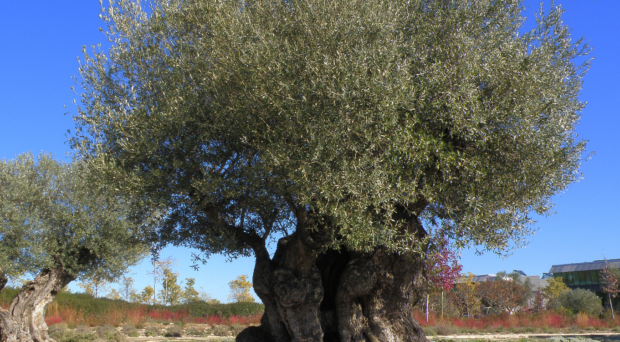
On the contrary, the richness in the mono-unsaturated fatty acids of olive oil has been praised by many dietary studies. Among the many different olive oil varieties, Picual is one of my favorites. I like its strong flavor, particularly when it comes extra virgin, unfiltered, and cold-pressed, from any of the many small producers that still handle their trees and products with sufficient time and care.
History of the olive tree
Olive trees themselves can constitute living monuments. Often reaching ages of over a thousand years, the beauty of these trees is not in their size, which is generally modest, but in the capricious shapes of their trunks, a testimony of a slow growth in a harsh climate.
The Mediterranean olive tree is one of the first domesticated crops, with the first cultivation evidence coming from the early Bronze Age. From the earliest domestication centers in the Levant, the art of cultivating olive trees was spread around the Mediterranean basin by diverse civilizations.
Despite much research, there are still many open questions regarding the history of the domestication of the olive tree, and we know very little about the genetic determinants of selected traits in the different varieties.
Nowadays roughly 3 million tons of olive oil is produced annually and there are many different olive varieties, each with a particular flavor and texture. With a slow growth and decades needed to reach full production, it is striking how the domestication process and the selection of new tree traits and olive varieties were driven across generations.
Despite much research, there are still many open questions regarding the history of the domestication of the olive tree, and we know very little about the genetic determinants of selected traits in the different varieties.
The first olive tree genome
Further advance in our knowledge was precluded in part by a lack of a reference genome for this important crop. This is no longer the case, as the first assembly of the Mediterranean olive tree genome and its annotation is published and described in our article in GigaScience.
The article focuses on the description of the assembly and annotation of a genome obtained from a 1300 year-old tree from the Farga variety. Several additional analyses are ongoing and will form parts of successive publications.
This publishing strategy accelerates the release of the reference genome to the scientific community without any restrictions, and lets us focus subsequent articles on specific questions of biological relevance. Our assembly approach uses a combination of short-read sequences of fosmid pools and whole genome shotguns, which enables us to reach a high level of completeness with the data.
Although not in our initial plans, the discovery of significant traces of ‘contaminating’ genetic material enabled us to partially assemble the genome of a new variety of the fungus Aerobasilium pullulans, which is known to associate with olive trees. As for the first analyses of the olive tree genome, the most relevant finding is that of an enlarged gene repertoire as compared to other plants, including the yellow monkey flower (Erythranthe guttata), which belongs to the same taxonomic order as the olive tree (lamiales).
A ratio of roughly 2 to 1 in the number of genes between the olive tree and the wild flower, and their patterns of similarity, suggest a recent large-scale gene expansion in the lineage leading to the olive tree
Inflated gene counts can also arise from assembly problems in diploid organisms, when distinct alleles of the same genomic region end up in different contigs. We discarded that factor by confirming that recently duplicated genes in the olive tree did not have a significantly lower level of heterozygosity, as would be expected if resulting from the said assembly artifact.
A ratio of roughly 2 to 1 in the number of genes between the olive tree and the wild flower, and their patterns of similarity, suggest a recent large-scale gene expansion in the lineage leading to the olive tree. Whole genome duplications are common in the evolutionary history of plants, including the most analyzed crops. Determining when and how the olive tree genome expanded its genetic repertoire is one large part of the current focus of our project.
Boosting research
The availability of a reference genome assembly for the species will boost research in the olive tree. Genome re-sequencing, which is more cost-effective than de novo sequencing, will help us in elucidating the past of the olive tree (from the early history of domestication) by comparing several subspecies of wild relatives to the origin of the different varieties, studying genetic makeup and uncovering regions subject to strong selection.
Analysis of the genetic diversity among different cultivars and wild relatives will also help us understand how the different traits are determined, as the underlying molecular bases of phenotypic differences including flavor, size, and oil content, remain poorly understood.
Genome-enabled studies such as the analysis of gene expression to the development of gene markers will certainly benefit from this resource, and will promote the understanding of olive tree physiology and its interactions with pathogens and other associated organisms. Eventually this knowledge will pave the way to improve olive tree handling, and accelerate breeding programs that aim to create novel varieties. I am already salivating, and feeling the need for a crunchy toast covered with olive oil and a bit of salt.
Toni Gabaldón
Latest posts by Toni Gabaldón (see all)
- A genome for the olive tree - 4th July 2016
Comments